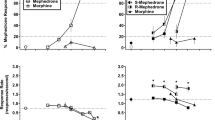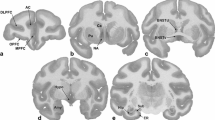Abstract
Rationale:Neurochemical and clinical studies indicate involvement of noradrenergic (NE) neurotransmitter system in the actions of methamphetamine. Objective:The present study investigated NE involvement in the discriminative-stimulus effects of methamphetamine. Methods:In Sprague-Dawley rats trained to discriminate 1.0 mg/kg methamphetamine, IP, from saline under a fixed-ratio schedule of food presentation, effects of various NE agonists, antagonists and uptake inhibitors were tested. Results: Desipramine (3.0–18.0 mg/kg) and nisoxetine (5.6–30.0 mg/kg), two selective NE-uptake inhibitors, did not significantly generalize to methamphetamine when administered alone, but 5.6 mg/kg desipramine and 10.0 mg/kg nisoxetine significantly shifted the methamphetamine dose-response curve to the left. The beta NE agonist, isoproterenol (0.56–3.0 mg/kg), and antagonist, propranolol (1.0–18.0 mg/kg), neither generalized to methamphetamine when given alone nor altered the discriminative-stimulus effects of methamphetamine when administered in combination. The alpha-1 NE agonist methoxamine (1.0–5.6 mg/kg) failed to generalize to the methamphetamine training stimulus. When given in combination with methamphetamine, the alpha-1 NE antagonist, prazosin (1.0 mg/kg), shifted the methamphetamine dose-response curve somewhat to the right and partially blocked the discriminative-stimulus effects of the 1.0 mg/kg training dose of methamphetamine, but these changes were not significant or dose-related, with further increases in prazosin dose (1.8–10.0 mg/kg) either producing similar or smaller changes. The alpha-2 NE agonist, clonidine, partially generalized to methamphetamine at doses of 0.1–0.18 mg/kg and increased drug-appropriate responding at lower doses of methamphetamine, but it partially blocked the discriminative-stimulus effects of higher 0.56–1.0 mg/kg doses of methamphetamine over the same dose range. The alpha-2 NE antagonist, yohimbine, also partially generalized to methamphetamine and blocked the discriminative-stimulus effects of the 1.0 mg/kg training dose of methamphetamine at doses of 5.6–10.0 mg/kg. A lower 3.0 mg/kg dose of yohimbine increased methamphetamine-appropriate responding when given together with low 0.1–0.3 mg/kg doses of methamphetamine. Conclusions:The present data suggest that the NE system plays a modulatory role in the discriminative-stimulus effects of methamphetamine. These effects appear to be mediated through NE uptake sites and alpha-2 receptors, with limited involvement of alpha-1 receptors and beta receptors.
Similar content being viewed by others
Author information
Authors and Affiliations
Additional information
Received: 14 August 1998 / Final version: 27 November 1998
Rights and permissions
About this article
Cite this article
Munzar, P., Goldberg, S. Noradrenergic modulation of the discriminative-stimulus effects of methamphetamine in rats. Psychopharmacology 143, 293–301 (1999). https://doi.org/10.1007/s002130050950
Issue Date:
DOI: https://doi.org/10.1007/s002130050950




